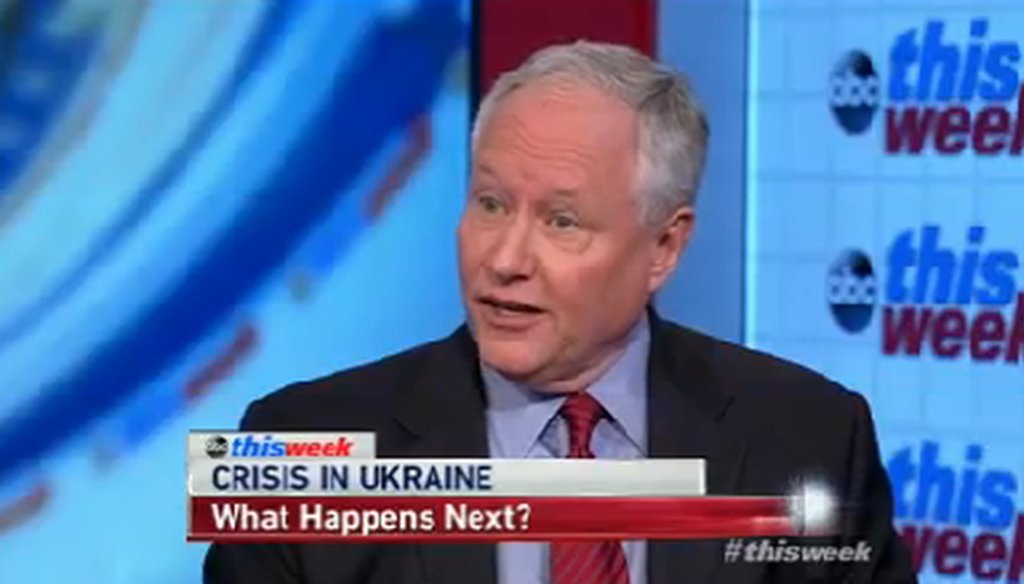Stand up for the facts!
Our only agenda is to publish the truth so you can be an informed participant in democracy.
We need your help.
I would like to contribute

Bill Kristol discusses the events in Ukraine on ABC's "This Week."
Violent uprisings in Ukraine had pundits and politicians wondering Sunday if the Eastern European country will be the first theater in a new Cold War between the United States and Russia.
On Fox News Sunday, U.S. Sen. Kelly Ayotte, R-N.H., set up the conflict as a proxy struggle between President Barack Obama and Russian President Vladimir Putin.
"I believe the president needs to up his game and send a clear, unequivocal, public message to Putin not to interfere in what is happening in Ukraine – to let the Ukrainian people determine their future, to ensure that there is (no) interference in their sovereignty," Ayotte said.
Others debated to what extent the United States should be involved.
Bill Kristol, the conservative editor of the Weekly Standard, generally trends toward greater intervention. On ABC’s This Week, he talked about the 2004 political revolution in Ukraine, and how the United States did not do enough to let democracy take hold.
Sign up for PolitiFact texts
"Ten years ago there was the Orange Revolution in Ukraine, it was the first color revolution in spite of other efforts around the world. … All honor to the people of the Ukraine," Kristol said. "That first revolution unfortunately slipped away. I think that’s partly our fault, the west Europeans’ fault. We didn’t do as much as we could have to help the newly democratic Ukraine."
Whether the United States did as much as it could for Ukraine is out of the purview of fact-checkers. But we can see if Kristol was right that the Ukraine Orange Revolution set off a series of color revolutions across the world.
It did not, experts told us.
The first color revolution took place in Georgia in November 2003, when Georgian protesters overthrew the government of Eduard Shevardnadze and elected 35-year-old U.S. educated Mikheil Saakashvili.
Ukraine’s Orange Revolution came a year later and ended when opposition leader Viktor Yushchenko was elected president. The revolution was originally branded "orange" because that was Yuschenko’s signature campaign color.
As such, Kristol’s claim rates False.
On NBC’s Meet the Press, a roundtable of experts also touched on domestic issues, including the forthcoming release of President Obama’s 2014-15 budget proposal.
The big headline? Obama is dropping a proposal to reduce the annual growth in Social Security benefits. The technical term is "Chained CPI" (Consumer Price Index).
The decision has big economic consequences, said David Brooks of the New York Times.
"Chained CPI would save $1 trillion in the second decade off the federal budget debt," Brooks said.
Chained CPI matters because so many bits and pieces of the government’s business are indexed to inflation. The list includes tax brackets, pension benefits, the cut-off point for tax credits, who’s eligible for food stamps, and most prominent of all, Social Security benefits.
The aim of all this indexing is to keep everything in line with the actual cost of living. If a retiree has $100 to spend on groceries today, 15 years from now he or she should be able to buy the same amount of food even if prices went up.
The problem is, economists generally agree that the way the government measures inflation today exaggerates inflation by a tiny bit. The technical problem is that as prices of some goods and services rise, people will change what they buy. Chained CPI adjusts for that.
The $1 trillion figure comes from a group called the Committee for a Responsible Federal Budget, which advocates for aggressive steps to cut deficits. In a fact sheet, the group wrote "The chained CPI would reduce the deficit by over $1 trillion in the second decade."
The estimate uses work from the Congressional Budget Office, the nonpartisan budget analysts used by Congress, but is not an official CBO estimate, said Jason Peuquet, a research fellow at the Committee for a Responsible Federal Budget.
For good reason.
CBO sometimes goes beyond a typical 10-year window, but it offers many caveats when it does. In a long-term projection for Social Security, for instance, CBO ran 500 different scenarios. It stood by the general direction of its conclusions but not the specific numbers.
Also, the chained CPI estimate Brooks cited goes beyond what Obama proposed last year. In 2013, the president exempted programs for low-income people and offered extra payments for Social Security recipients who had been on the rolls a long time.
Those caveats would bring down the savings, no matter what the real number is.
We rate Brooks’ statement Half True.
Times Staff writers Jon Greenberg and Julie Kliegman contributed to this report. Aaron Sharockman is the editor of PunditFact.com.
Our Sources
See individual fact-checks.




























